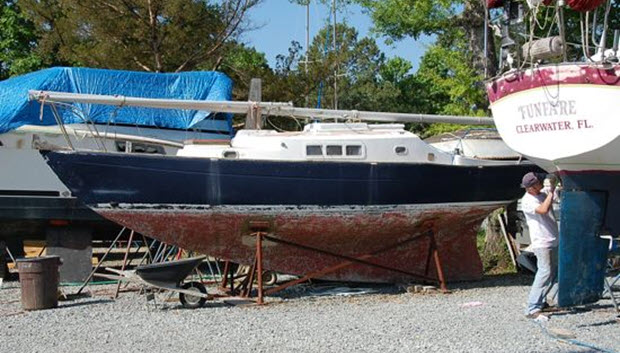
Regular contributor Don Street reminds us that boat ownership is within the grasp of anyone with a bit of imagination. As the heyday of fiberglass boat construction has created a glut of used boat, here’s his playbook for anyone seeking a sailboat on the cheap:
Wander through boat yards and find an abandoned or semi-abandoned boat 32 feet or smaller constructed of solid fiberglass, no core of balsa or other material, osmosis free. The boat will be available either for free or at minimal cost
Buy the boat, and as the engine is undoubtedly shot, remove it and try to sell it. Clean-up the engine compartment with a high pressure wash, plenty of soap, and scrub brush. Remove the shaft, propeller, and then plug up the aperture.
Back in the late 50s and early 60s in the Caribbean, when parts were either unavailable or would take six or more months to obtain, we discovered that removing the propeller did not improve the sailing performance. However, we discovered if you plugged up the aperture, sailing performance increased very significantly.
Install a big oarlock on the stern, buy a 12 foot oar and learn how to scull.
Get rid of all incandescent bulbs, replaced with LED. Get rid of running lights and install a single three-way mast head light with an LED bulb.
Where the engine was, install two separate big banks of batteries. Make the individual batteries small enough to be carried ashore and charged. When one bank of batteries runs flat, switch to the other bank and carry ashore and recharge the batteries in the flat bank. Or go alongside a marina dock for 24 hours and recharge the batteries.
If the chain plates are encased in fiberglass, grind off the fiberglass and you will probably discover some nasty black stuff about ready to fall apart. Replace chain plates. Reinstall them in a way they can be regularly inspected. If the chain plates can be inspected but go through the deck, be sure to remove the chain plates and examine for corrosion with the chain plate pass through the deck.
Examine mast carefully, but it is amazing how long aluminum mast will last. Mast may be fine, possibly need some repair, or must be discarded. A used mast can be adapted and are available at a reasonable price.
Mast will probably be stepped on the keel. If keel is bare-metal uncovered by fiberglass, make sure there is a heavy ground wire from the mask to a keelboat. If the ballast is encapsulated, install on the outside of the hull a 12″ square copperplate with a bolt through the hull to a wire going to the foot of the mast. This should protect the boat from structural damage by a lightning strike.
Examine standing rigging carefully, especially the swage fittings. If rigging needs to be replaced, you can do it yourself using stay lock or Norsemen fittings. Stay lock are easier to assemble then Norsemen.
The sails are probably shot. If possible obtain a sail plan from the builder or designer. If none is available, measure up the boat and rig carefully and make your own sketch. Forget about new sails and go to Bacon Associates in Annapolis, Maryland. They have been selling second hand sails for probably 80 years.
The boat undoubtedly will not have a roller furling headsail gear as prior to the 1990s sailors happily sailed with hanked on headsails. If not available with hanks, get out a palm, needles, sail twine, wax, and sew hanks on to the luff of the headsails.
Check stores that carry secondhand marine equipment and find a good small solid fuel stove to heat the main cabin. Once installed you can stretch the New England sailing season, go in the water beginning of April and not come out until November, allowing for uncrowded spring and fall anchorages. In the Chesapeake and areas south, you can stay in commission all year if you have a solid fuel cabin heater
Remember the old U.S. Navy motto KISS: Keep It Simple and get Sailing.

